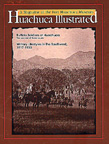 Indian Scouts at Huachuca in the 1920s and 1930s
Indian Scouts at Huachuca in the 1920s and 1930s Indian Scouts at Huachuca in the 1920s and 1930s
Indian Scouts at Huachuca in the 1920s and 1930s
In 1922 the scouts were moved to Fort Huachuca which would become their permanent home until the remaining few retired in 1947. At Huachuca they patrolled the boundaries of the military reservation and took part in ceremonial functions, stirring memories of a proud past.

Apache Indian Scouts at Huachuca in 1934.
On March 18, 1924, a first sergeant of scouts with the colorful name of Sergeant Chicken retired from the Army at Fort Huachuca. His Apache name, all but unpronounceable to the Americans he served with, was Eskehnadestah. He had first joined the Army in 1893 and was a trailer for General Pershing's 1916 Punitive Expedition after Pancho Villa. A lieutenant on the expedition had praise for the senior scout. "First Sergeant Chicken is probably, all things considered, the most valuable man in the detachment. He is finishing his seventh enlistment period. He speaks pretty fair English, is an excellent trailer and scout, and an absolutely reliable man."
Chicken retired to Whiteriver on the reservation where he lived to the age of 95, dying on February 3, 1955.
Colonel Allen C. Miller II was a former commander of Apache scouts at Fort Huachuca and he remembered well when, in 1933, the Army built new quarters for them.
The scouts remained rugged individualists to the end. Only one of the last twelve scouts spoke English. All were very large, well built men. Not only were they excellent horsemen, but foot marches of up to 85 (?) miles in a single day are recorded. Individually and as a unit they were fine soldiers, but they never gave up many of their tribal ways. Until the mid-thirties they lived with their families in tepees which were located in an area of the garrison some distance apart from the other troops. When the WPA (Works Projects Administration) offered to improve their housing conditions, the post commander at Fort Huachuca enthusiastically set about building adobe houses for the.Indians. An impressive dedication was held to celebrate the movement of the Indian families into their new quarters. Great was his consternation to find soon thereafter that all the families had moved back into tepees and that the scouts' horses were the only occupants in the new quarters.(66)
 David B. Stone was a 2d Lieut. with the 25th Infantry
from 1935-7, and, like so many other veterans of Huachuca, remembered vividly
the Apaches.
David B. Stone was a 2d Lieut. with the 25th Infantry
from 1935-7, and, like so many other veterans of Huachuca, remembered vividly
the Apaches.
The Apache Scouts were still active, and an integral part of the Fort garrison. Their function was to patrol the Fort's extensive boundaries, about 10 to 20 miles each side of a rectangle. They lived In their broken down little hogans and kept their chickens and pigs in the quarters the Army built for them.(67)
Sinew Riley and wife, Peela, at Fort
Huachuca in 1935.
Photo courtesy Rev. Arthur A. Guenther, Lutheran
Apache Mission, Whiteriver, Arizona.
Other duties relegated to the Apaches since their assignment to Fort Huachuca was to appear in their traditional dress in parades and reviews. If their traditional dress did not always coincide with the expectations of the press or movie directors, they would embellish their costumes a little, adding feathers and headdresses. After all they were representing not only Apaches but all Indians who had served the Army as scouts. An April 6, 1938, article in the Arizona Republic reported about an Army Day celebration at the fort:
One of the colorful events of the afternoon program was the appearance of the Apache Indian scouts in a simulated attack on a covered wagon train. The Apaches were clad in colorful ceremonial costumes and remained on the field for about a quarter of an hour to pose for literally hundreds of candid camera fans and amateur movie directors.
The Quartermaster Corps had to order twenty-five crossed arrow insignias in January 1941. These would be for the eight remaining Apache Scouts stationed at Fort Huachuca. These men were Sergeant Sinew Riley, 49; Corporal Ivan Antonio, 52; Corporal Alejo J. Quintero, 51; Private Jess Billy, 47; Private Kessay, 43; Private Jim Lane, 51; Private William Major, 39; and Private Andrew Paxton, 53.
Wharfield reported that "Corporal Alejo Quintero retired in 1941, Private Jess Billy in 1944, and Private Jim Lane in 1945. About the same time Private Andrew Paxton was thrown from his horse and died in the Fort Huachuca hospital."

Twenty-two wickiups once dotted the area near the
present post cemetery. The Indians preferred their traditional homes over
the adobe huts built for them, and until the post commander suggested they
make use of the new buildings, they more often than not used the huts as
store rooms.
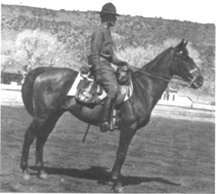 --------
--------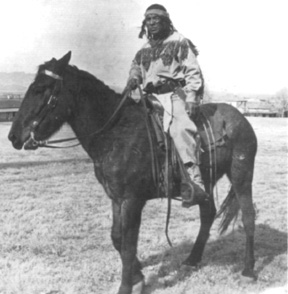
--------Captain John
C. F. Tillson, 10th Cavalry, ----------------Sergeant Sinew Riley on horseback on the parade field at
Fort Apache, Arizona, in 1918. ------------------------Fort Huachuca, probably in the 1930s.
The quarters of 1st Lt. H.B. Wharfield, ------------------------Photo courtesy Rev. Arthur A. Guenther,
10th Cavalry, is at the right. Photo courtesy Col H.B. Wharfield.--------Lutheran Apache Mission,
Whiteriver, AZ.
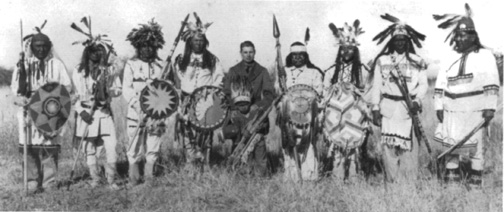
Apache Scouts in costume around 1939. Photo courtesy
Rev. Arthur A. Guenther, Lutheran Apache Mission, Whiteriver, Arizona.
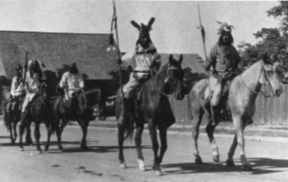 -----
-----
The Apache Scouts participate in Tombstone's --------------------Apache
Scout Kessay mounted on the parade field,
Helldorado Days in Tombstone, Arizona, in the 1930s.---------------in the early 1940s.----------------------------------------

Apache scouts in costume with unknown civilian.
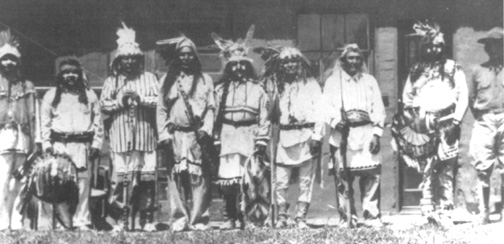
In this 1930s picture, the scouts are dressed in costume
in front of their huts. Photo courtesy of Rev. Arthur Guenther.

Sinew Riley with his son at Huachuca in the 1930s.
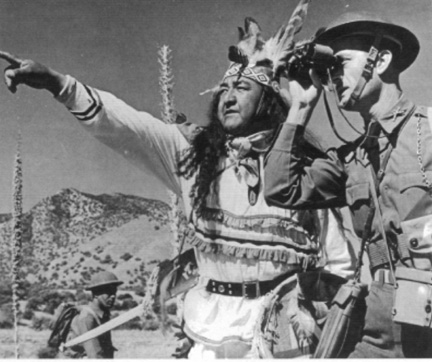
Apache Scout William Major with an officer of the
25th Infantry in the 1930s.
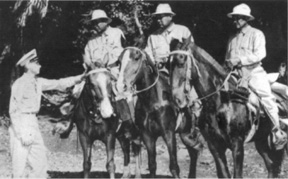
Apache Scouts on horseback with unknown officer.
Photo courtesy Rev. Arthur A. Guenther, Lutheran Apache Mission, Whiteriver,
Arizona.

"Last of the Indian Scouts, Fort Huachuca, Arizona."
They are from left to right: Sinew Riley, Jess Billy (or Joe Quintero),
William Major, Antonio Ivan, and Andrew Paxson.
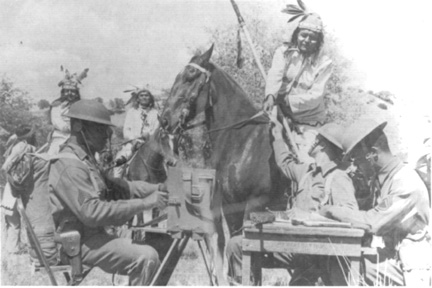
 ---
---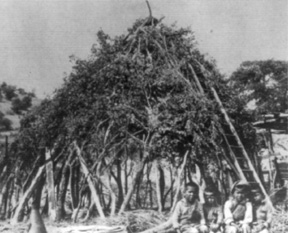
Indian Scouts, their families, and wickieup at Huachuca.
in 1934. ----Wickiup
homes of Apache Scouts at Fort Huachuca, near
Photo courtesy Mrs. Robert S. Knox, widow of Col. Robert ----------the cemetery area. Apache Scouts lived here. Photo courtesy
Soutter Knox, who in 1934 commanded the 25th Infantry ------------of Rev. Arthur A. Guenther, Lutheran Apache Mission,
and Fort Huachuca.----------------------------------------------------------Whiteriver, AZ 85941.
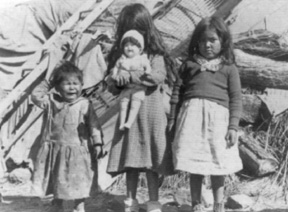
Children of Indian Scouts at Fort Huachuca in 1934.
Photo courtesy Mrs. Robert S. Knox.
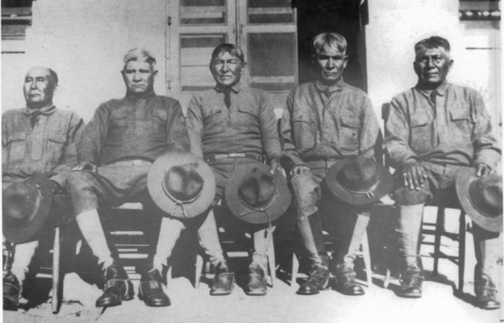
Indian scouts at Fort Huachuca in 1929. Left to right:
Sgt. Deklay, Sgt. Charley Bones, Sgt. Chow Big, Eskipbygojo, Unknown. Photo
courtesy of John D. McCaskey.
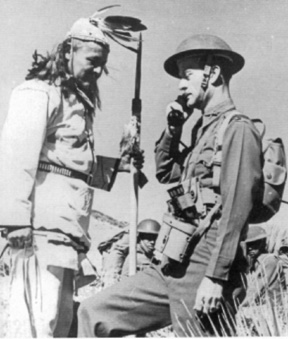 --
--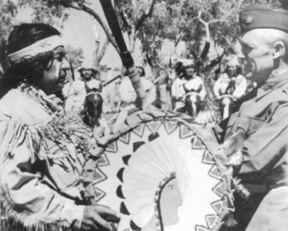
An Apache Scout in costume with infantrymen ------------------------Apache
Scout Sinew Riley and Col. Lee D. Davis,
of the 25th Infantry in the early 1940s.------------------------------------commanding the 25th Infantry in 1939.
Footnotes: